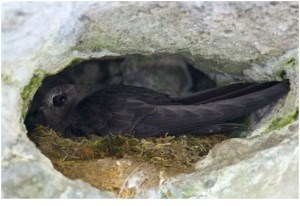
Another of Jasper National ParkÔÇÖs species has made the dreaded list.
The black swiftÔÇöa bird that nests behind waterfalls and migrates long distances to forrage for insectsÔÇöis among 20 new species recently assessed as a species at risk by the Committee on the Status of Endangered Wildlife in Canada (COSEWIC).
In JNP, the black swift joins numerous other species, some that have recently joined the ranks and others that have been listed for years.
Like JasperÔÇÖs whitebark pine and caribou, it is now assessed as endangered.
COSEWIC lists species in seven different risk categories, with extinct at the top of the list and deficient data at the bottom. In between there is everything from threatened to not at risk.
Once assessed, COSEWIC gives its recommendations to the Minister of Environment, who determines whether to include the recently assessed species in the Species at Risk Act.
Once in the act, legal obligations kick in. For instance, with endangered species, critical habitat must be identified in a recovery plan.
Although the process is seemingly straightforward, in practice there doesnÔÇÖt seem to be any benefit to being listed in the act.
That was the finding of a 2014 study completed during the University of Victoria Research Derby.
Scientists looked at 369 at-risk species that had been assessed more than once by COSEWIC and noted that of those examined, the status of 115 had deteriorated, while 202 species remained unchanged and 52 had improved. (ItÔÇÖs worth noting that only 20 improved to the point where they were considered ÔÇťnot at risk.ÔÇŁ)
ItÔÇÖs concerning to think that the very legislation that is meant to protect endangered and threatened species and their habitats bears little weight on their survival.
Instead it seems the list just grows longer and the plight of at-risk species grows increasingly worse.
If we carry on down this path, soon we will lose hundreds of species, never to be seen again.
ThatÔÇÖs why itÔÇÖs time for an overhaul. The Species at Risk Act needs more teeth. It needs to be more efficient and it needs to create real action.
Otherwise, our grandchildren will never see a caribou in the Tonquin Valley, a black swift in Malgine Canyon or a bull trout in the Saskatchewan River.
Rather, those speciesÔÇöspecies we had the opportunity to saveÔÇöwill only live on in storybooks.
